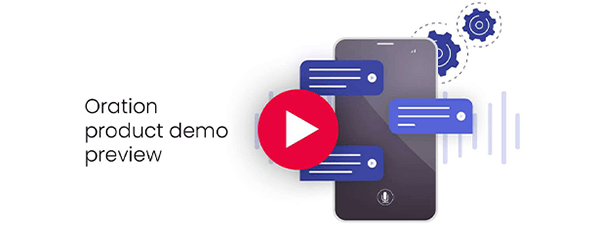Excellent customer service is what gives businesses a competitive edge. In fact, PWC1 surveyed 15,000 people across 12 countries and found 73% of consumers believe customer service and experience is an important factor in their purchasing decisions. As the first point of contact, contact centres and their customer service teams are on the frontline when it comes to creating great first impressions, engaging with customers and building a top reputation in the market.
It's easy to see how contact centre technology can make or break the customer experience and, ultimately, have a negative impact on the bottom line – especially in the current marketplace. In fact, 83% of businesses believe artificial intelligence (AI) is a key priority2 in their plans to improve customer experience. Imagine a scenario where a caller attempts to navigate restrictive push button menu options, only to wait in a lengthy call queue to find out that they have come through to the wrong department or agent.
This type of frustrating experience puts a barrier between the customer and the brand which could easily prevent them from buying products or services again. What's also important to understand is that customers today have more choices when it comes to finding the customer experience they are looking for.
Content Guide
What is interactive voice response?
Interactive voice response (IVR) is like the helpful assistant you never knew you needed. This automated telephony system interacts with callers, gathers information and routes calls to the appropriate recipient. IVR systems use pre-recorded voice prompts and touch-tone keypad entry to collect information from callers, allowing them to navigate a phone system without speaking to a live agent. This technology is a staple in customer service, streamlining processes and efficiently managing high call volumes.
What are the key features of IVR?
Automated call routing:
directs calls to the appropriate department or agent based on caller input. IVR systems can quickly identify and transfer calls to the right department, reducing wait times and making sure customers get the help they need, fast.
Pre-recorded messages:
provides information or instructions through automated voice prompts. These messages ensure that every caller gets the same accurate information, whether it's business hours or account details, ensuring a consistent experience every time.
Touch-tone input:
allows callers to use their phone keypad to make selections. This feature lets callers navigate menus and access information or services without needing to speak to an agent, speeding up the process and reducing frustration.
Queue management:
handles high call volumes by placing callers in a queue and providing wait time estimates. IVR systems can manage multiple calls simultaneously, keeping customers informed about their wait time and improving overall satisfaction.
Integration with databases:
accesses customer information and account details to provide personalised services. By connecting to backend databases, IVR systems offer tailored responses based on the caller's account status or history, making interactions more relevant and efficient.
What are the advantages and limitations of IVR?
Advantages
- Cost efficiency: reduces the need for live agents, lowering operational costs. IVR systems handle routine enquiries and tasks, freeing up human agents to tackle more complex issues, which means you save money while still delivering great service.
- 24/7 availability: provides round-the-clock service without the need for human intervention. Customers can access information or perform certain actions at any time, improving convenience and ensuring they get the help they need when they need it.
- Consistent service: ensures uniformity in customer interactions and information delivery. Automated responses eliminate the variability of human interactions, offering a reliable experience for callers every single time.
- High volume handling: manages large numbers of calls simultaneously. IVR systems can process multiple calls at once, ensuring that no caller is left waiting unnecessarily and enhancing overall efficiency.
Limitations
- Limited interaction: can only handle predefined queries and tasks, which can be frustrating for callers with more complex needs. IVR systems may struggle with issues that require nuanced understanding or personalised assistance, leaving some customers feeling a bit stuck.
- Impersonal experience: lacks the personal touch of human interaction, which can affect customer satisfaction. Callers may feel disconnected or frustrated when dealing with an automated system, especially if their issue isn't straightforward.
- Static routing: routes calls based on fixed options, which may not always address the caller's specific issue efficiently. IVR systems may not adapt well to unique or unexpected enquiries, leading to longer resolution times and potential frustration.
What is an intelligent virtual agent?
An intelligent virtual agent (IVA) is like having a super-smart, AI-powered assistant ready to help at a moment's notice. Designed to interact with customers using natural language understanding (NLU) and machine learning, IVAs can understand and respond to spoken language, making interactions feel more natural and engaging. These agents can handle a wide range of customer service tasks, from answering enquiries to performing transactions, all without the need for human intervention.
What are the key features of IVA?
Conversational AI:
uses NLU to understand and respond to customer enquiries in a natural, human-like manner. This allows for fluid and engaging interactions, making customers feel heard and understood, almost like they're talking to a real person.
Intelligent call routing:
routes calls based on real-time understanding of the caller's intent. Unlike traditional IVR, IVAs adapt on the fly, solving problems and completing tasks more efficiently and accurately.
Integration with business systems:
connects with CRM, payment systems, and other databases to provide personalised and efficient service. For example, an IVA platform like Oration by Convai lets contact centre managers set up unlimited targeted banners to address common call types, providing tailored responses and actions.
Self-service capabilities:
enables customers to complete tasks such as payments, bookings, and information retrieval on their own. IVAs empower customers to take control, allowing them to make payments, check balances, book appointments and more without ever needing to speak to a real agent.
Omnichannel support:
provides a seamless experience across multiple communication channels, including phone, chat, SMS and email. An IVA can be configured to offer customers the chance to switch their interactions to live chat or SMS, ensuring a smooth and versatile customer service experience.
What are the advantages and limitations of IVA?
Advantages
- Enhanced customer experience: offers a more personalised and interactive experience compared to traditional IVR. The ability to personalise interactions is a key differentiator between IVR and IVA. For instance, an IVA can recognise caller intent from their speech and provide tailored responses or actions, making each interaction feel unique and personal.
- Increased efficiency: automates complex tasks and provides quick resolutions, reducing wait times. AI-powered conversational speech recognition technology ultimately means that callers can get from A to B in fewer steps compared to traditional interactive voice response systems, making the process faster and smoother.
- 24/7 availability: operates round the clock, providing continuous service without downtime. Customers can complete tasks or find information 24/7, regardless of contact centre opening hours, giving them the freedom to get help whenever they need it.
- Scalability: easily scales to handle fluctuating call volumes and business growth. IVAs can adapt to increased demand without compromising performance or customer experience, making them a robust solution for growing businesses.
- Integration: seamlessly integrates with various business applications and databases, enhancing functionality and customer insights. CRM integration ensures that information about the call and any data captured is always recorded against the customer for future reference, enabling more informed and efficient service.
Limitations
- Initial setup cost: higher implementation costs due to advanced technology and integration requirements. Developing and deploying an IVA involves significant investment in AI and machine learning infrastructure, but the long-term benefits can outweigh these initial costs.
- Complexity: requires sophisticated AI training and maintenance to ensure accurate performance. Continuous monitoring and updates are necessary to maintain the IVA's effectiveness and accuracy, which can require ongoing resources and expertise.
- Security concerns: handling sensitive information through AI systems necessitates stringent security measures. Ensuring data privacy and protection is crucial when dealing with customer information in automated systems, making security a top priority for any IVA implementation.
Difference between IVA and IVR: how do they compare?
IVR systems use touch-tone menus and basic speech recognition to route callers to the right department or information. IVA leverages artificial intelligence and natural language processing to engage in more complex, human-like conversations and resolve issues independently.
Based on interaction style
- IVR: IVR systems rely on touch-tone keypad inputs and pre-recorded messages. Customers navigate menus by pressing numbers, which can sometimes feel robotic and impersonal.
- Best for: traditional businesses with straightforward, high-volume call handling needs, such as utilities, banks and healthcare providers, where customers often seek routine information like account balances, office hours or appointment confirmations.
- IVA: IVAs use advanced conversational AI and natural language processing to interact with customers. This means customers can speak naturally, and the IVA understands and responds in a human-like manner, making the experience more engaging and personalised.
- Best for: innovative and customer-centric businesses, such as eCommerce, tech companies and premium service providers, where personalised, high-quality interactions are crucial for customer satisfaction and retention.
Based on call routing
- IVR: IVR systems route calls based on a fixed set of options. Callers choose from predefined menu items, which can lead to frustration if their issue doesn't fit neatly into one of the categories.
- Best for: organisations with predictable call types and clear-cut routing needs, like government agencies, insurance companies and educational institutions, where calls typically fall into a few distinct categories.
- IVA: IVAs dynamically route calls based on real-time understanding of the caller's intent. By asking open-ended questions like "How can I help you today?", IVAs can quickly determine the caller's needs and route them to the appropriate solution or agent.
- Best for: businesses with diverse customer needs and complex service offerings, such as travel agencies, telecom providers and financial services, where a personalised approach can significantly enhance the customer experience.
Based on self-service capabilities
- IVR: IVR systems provide basic self-service options, such as checking account balances or making simple payments, but their capabilities are limited by the predefined menu options.
- Best for: companies looking to automate simple, repetitive tasks, such as utilities, fast-food chains and basic retail, where customers frequently need quick access to common information or simple transactions.
- IVA: IVAs offer robust self-service options that go beyond what IVR can provide. Customers can perform complex tasks like making payments, booking appointments and even troubleshooting issues without needing to speak to a live agent. IVAs can also access various business systems to complete these tasks seamlessly.
- Best for: modern, tech-savvy businesses, such as online marketplaces, advanced retail and tech support services, where empowering customers to handle more complex tasks independently can lead to higher satisfaction and efficiency.
Based on personalisation
- IVR: personalisation in IVR systems is minimal. Callers typically receive the same prompts and options regardless of their previous interactions or specific needs.
- Best for: businesses with standardised service models, such as public services, transportation and basic customer service lines, where interactions are generally uniform and don’t require significant customisation.
- IVA: IVAs excel at personalisation. They can recognise callers from previous interactions, access customer records and provide tailored responses based on the caller's history and preferences.
- Best for: customer-focused industries, such as luxury brands, high-end hospitality and bespoke service providers, where personalised service can be a key differentiator and a driver of customer loyalty.
Based on integration with business systems
- IVR: integration capabilities of IVR systems are often limited. While they can access some databases to retrieve basic information, their ability to interact with multiple business systems is restricted.
- Best for: smaller or less tech-integrated businesses, such as small healthcare practices, local government offices and small-scale retail, where complex integrations are not a necessity.
- IVA: IVAs are designed to integrate seamlessly with a wide range of business applications, including CRMs, payment gateways and booking systems. This integration allows IVAs to provide comprehensive solutions and handle complex customer requests efficiently.
- Best for: tech-forward businesses and large enterprises, such as multinational corporations, large financial institutions and integrated service providers, where advanced system integration can streamline operations and enhance customer service.
Based on customer experience
- IVR: the experience with IVR systems can sometimes be frustrating due to the rigid structure and limited interaction options. Callers may feel like they're navigating an endless maze of menus.
- Best for: organisations where quick, transactional interactions are sufficient, such as utility companies, basic retail and public services, where the primary goal is to handle a high volume of similar enquiries efficiently.
- IVA: IVAs offer a much smoother and more intuitive customer experience. The natural language interaction and dynamic problem-solving capabilities make customers feel understood and valued, leading to higher satisfaction and loyalty.
- Best for: businesses where customer experience is a competitive advantage, such as premium retail, high-end tech support and personalised financial services, where exceptional service can significantly impact customer loyalty and brand perception.
Based on scalability and efficiency
- IVR: IVR systems are effective for handling high call volumes, but their static nature can be a drawback when it comes to adapting to new customer needs or business processes.
- Best for: established businesses with stable and predictable call volumes, such as traditional banking, healthcare services and insurance, where the primary need is to efficiently handle routine enquiries.
- IVA: IVAs are highly scalable and can adapt quickly to changing business requirements. They can handle increasing call volumes without sacrificing performance and can be updated to incorporate new services and capabilities easily.
- Best for: growing businesses and dynamic industries, such as tech startups, innovative service providers and fast-growing eCommerce platforms, where flexibility and scalability are critical to keeping pace with changing demands.
Summary
In summary, while IVR systems have been a staple in customer service for years, IVAs represent the next generation of customer interaction technology. With their advanced AI capabilities, dynamic interaction style and robust self-service options, IVAs provide a more engaging, efficient and personalised customer experience. Whether you're looking to enhance your current system or make a leap into the future of customer service, understanding these differences will help you choose the right solution for your business.







